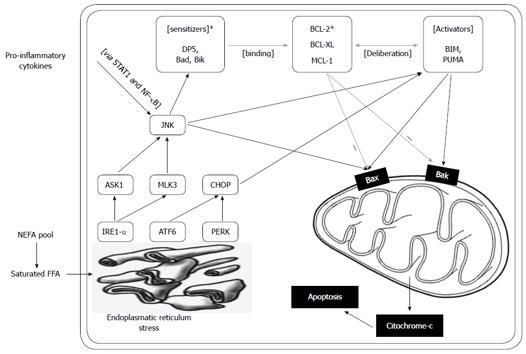Copyright
©2014 Baishideng Publishing Group Inc.
World J Gastroenterol. Jul 21, 2014; 20(27): 9072-9089
Published online Jul 21, 2014. doi: 10.3748/wjg.v20.i27.9072
Published online Jul 21, 2014. doi: 10.3748/wjg.v20.i27.9072
Figure 1 Endoplasmatic reticulum stress caused by saturated free fatty acids.
Endoplasmatic reticulum stress caused by saturated free fatty acids, via three main mediators [inositol-requiring endoplasmic reticulum-to-nucleus signal kinase 1α (IRE1α), activating transcription factor 6 (ATF6) and RNA-dependent protein kinase (PRK)-like endoplasmic roticulum (ER) kinase (PERK)], results in the activation of c-Jun N-terminal kinase (JNK) and C/ CCAAT/enhancer binding protein (EBP) homologous protein. The sequence of BH3 protein activation based on a sensitizer and an activator group was described by Gurzov and Eizirik in β-cells[62,63]. The sensitizers bind the anti-apoptotic proteins Bcl-2, Bcl-XL and Mcl-1 and release the activators from this bond. JNK both mediates the induction of the sensitizer and the activator BH3 proteins and also activates Bax. Upregulation of Bcl-2 interacting mediator of cell death (BIM) and p53 upregulated modulator of apoptosis (PUMA) was also demonstrated in liver cells as a ruslt of free fatty acid (FFA) induction. Proinflammatory cytokines also activate JNK. ER sterss also results in CHOP actvation and subsequently the activation of the activator BH3 proteins. This complex signaling pathway might link the metabolic (saturated FFAs) stress and the effect of pro-inflammatory cytokines both in the pancreatic β-cell as well as in liver cells.
- Citation: Firneisz G. Non-alcoholic fatty liver disease and type 2 diabetes mellitus: The liver disease of our age? World J Gastroenterol 2014; 20(27): 9072-9089
- URL: https://www.wjgnet.com/1007-9327/full/v20/i27/9072.htm
- DOI: https://dx.doi.org/10.3748/wjg.v20.i27.9072









